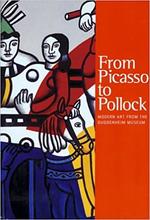More about Composition 8
- All
- Info
- Shop

Contributor
Few people actually know what they want to be when they grow up; at a certain point you just have to roll the dice and hope for the best.
Presumably that's how it went down for Kandinsky, and why he subsequently ended up in the insipid position of practicing law. That said, I feel as though Kandinsky should have known he was destined to be an artist. For starters, his parents shoved creativity and music down his throat from a young age. Kandinsky also suffered from this crazy condition known as synesthesia, meaning the stimulation of one sense would trigger another sense. Kandinsky could literally see color when he listened to music. I can’t even put into words how freaking ballin' that it, especially for an artist. All he needed to do was put on some jams and visual inspiration would appear. This condition is undoubtedly why so many of his paintings and their titles are a nod to music; this work is no exception.
Art and music remained synonymous to Kandinsky throughout his career. As Kandinsky once explained, “Color is the keyboard, the eyes are the harmonies, the soul is the piano with many strings. The artist is the hand that plays, touching one key or another, to cause vibrations in the soul.” Like I said, it is a mystery to me how this guy did not know he was an artist.
Of course it wasn't long after Kandinsky realized he was one of those creative types that the rest of the world got on board with his artistry too. He quickly caught the eye of important collectors, such as Solomon Guggenheim. The Guggenheim museum is like the ultimate mecca for Kandinsky enthusiasts today. In fact, Composition 8 was the first painting Solomon Guggenheim bought from Kandinsky, but it most definitely was not his last. Guggenheim bought more than 150 of his works over the years, making him one of Kandinsky's most avid supporters.
Kandinsky only awarded the title of Composition to his most prized work. He created only ten of these paintings over twenty-nine years; sadly only seven of them remain. See back in Kandinsky’s days, there were these pesky people out there confiscating and destroying “degenerate artwork”. Nazis I believe they were called. Anywho, they felt it necessary to destroy three of Kandinsky's beloved Compositions. Luckily, Composition 8 was spared, as Kandinsky viewed this painting as his greatest postwar achievement.
Sources
- Brooks, Katherine. “9 Things You Didn’t Know About The Artist Wassily Kandinsky”. December 16, 2014. Accessed September 14, 2017. http://www.huffingtonpost.com/2014/12/16/wassily-kandinsky-birthday_n_6…
- “Kandinsky: Compositions”. Accessed September 14, 2017. https://www.moma.org/calendar/exhibitions/448
- Miller, Renée. “Wassily Kandinsky’s Symphony of Colors”. March 19, 2014. Accessed September 14, 2017. http://denverartmuseum.org/article/staff-blogs/wassily-kandinskys-symph…
- “Vasily Kandinsky (1866–1944): Composition 8 (Komposition 8)”. Accessed September 14, 2017. https://www.guggenheim.org/arts-curriculum/topic/vasily-kandinsky-compo…

















